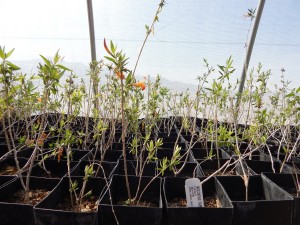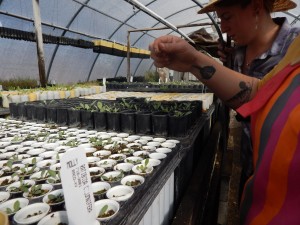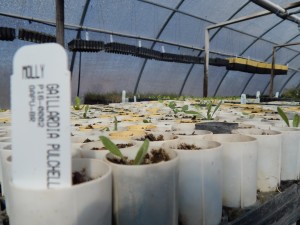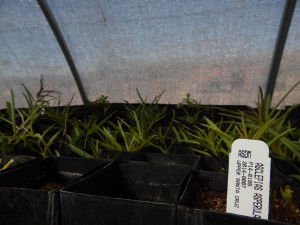
Francesca Claverie adores Heuchera, a hot pink and coral-red wildflower that calls to hummingbirds. She clings to Ratibida columnifera, a reddish-brown and yellow wildflower that grows in sunny, open grasslands. She cherishes Asclepias asperula, a perennial milkweed that monarch butterflies need to survive.
Fastened to Claverie’s bright multicolored, striped apron is a pin that reads, “I love natives.” Claverie lights up, appreciation radiating from her wide smile as she begins to speak about the native plants of the Arizona/Sonora border region.
“It is just so great to see things grow,” she said. “It feels so good, when the plants are beautiful and flowering.”
Claverie is the nursery manager at Borderlands Restoration in Patagonia, Arizona.
Borderlands Restoration is a low-profit, limited liability company, or L3C, which aims to reconnect wildlife, land and people in the Arizona/Sonora borderland region by restoring ecosystems.
Habitat restoration is a process of returning a damaged or degraded area back to a healthy, self-sustaining condition. Native plants play an important role in this restoration, providing keystone elements for the ecosystem.
Native species occur in the region in which they evolved, and because they evolve over geologic time in response to changes in the area, native plants possess certain traits that make them uniquely adapted to local conditions.
These plants help conserve biodiversity, encourage plant adaption in the face of climate change, help to restore watersheds and create pollination and migration corridors for insects, birds and other wildlife.

The Borderlands Restoration native plant nursery began with one greenhouse in 2012 and in four years has grown into a fully developed plant propagation program. Today the organic nursery has three greenhouses and has produced more than 40,000 native plants for landscape restoration on public lands, in national parks and monuments, private ranches, and backyard landscapes.
“We have our own niche for what we produce,” Claverie said. “We are not a fancy retail nursery and there are awesome nurseries in Tucson that do that so much better than we could, but here these are badass plants that are super hardy and we are just trying to make sure they survive in the wild.”
And here in border region, “we have one of the greatest biological diversities’ period, especially with plants,” Claverie said.
While we do live in a diverse place, according to Claverie, it isn’t enough to just have a stock list of native plants.
“If you are ignoring plants in an entire area and just not collecting seed from them, not growing them out and not putting them back into restoration in these areas,” said Claverie, “you are doing a huge disservice for what is already adapted and millions of years of evolution and genetic specialization.”
The unique Borderlands Restoration approach is to have variety within a plant species, so the restoration work is more effective.

“Here at Borderlands we can say we have a specific plant from these four different elevations, so depending on where you are trying to do the work or where you live, this is what you should be planting based on elevation, based on GPS coordinates, or what side of the mountain it was from,” Claverie said.
To make restoration more efficient and effective, Borderlands works with other organizations in the area with similar goals, including Sky Island Alliance.
The Sky Island region encompasses Southeastern Arizona and also Northern Sonora, where an amazing diversity of more than 4,000 native plants thrive. Like Borderlands, the Sky Island Alliance’s mission, according to their website, “is to protect and restore the biodiversity and natural heritage of the Sky Islands.”
Sky Island Alliance has been working with Borderlands for a few years now. Carianne Campbell, conservation director for the alliance, says Borderlands has been a wonderful partner, both in conducting on-the-ground restoration, but also having access to those restoration-quality native plant materials.
“Having the ability to get plants that were grown from seeds that were collected in the same watershed or very close to where we are doing a restoration project, allows us to maintain the genetic integrity and appropriate diversity for an area,” Campbell said.

One of these crucial native plants that helps maintain diversity is milkweed.
Milkweed sustains the monarch butterfly population in the region because monarchs can’t survive without the native plant. Caterpillars eat the milkweeds and the monarchs use them to lay their eggs.
“We have some of the highest diversity of milkweeds in the nation,” said Claverie. “Making sure the monarch butterflies have food as they are making babies and heading down to Mexico and Arizona is crucial and milkweeds are a vital component.”
Both Sky Island and Borderlands recently received a joint grant to produce and install as many of these milkweeds as they possibly can on up to 80 acres of federal land and 20 acres of private land.
“The grant pays for Borderlands to grow lots and lots of native milkweeds and it also pays for some of our time, Sky Island Alliance, to get those milkweeds that are produced by Borderlands out onto the landscape,” Campbell said.
These new milkweeds will be going to such places as Bear Canyon in the Catalina Mountains, Madera Canyon and Aravaipa Canyon.
Because native plant propagation is a group effort, and a lot of the work that is done is publicly funded, Claverie said, “it shouldn’t be a competition thing, but instead a sharing of resources and knowledge.”
And the milkweed project is just one example of this.

“There are limited resources out there to do this sort of work and we can absolutely be more efficient and more effective if we are coordinating our efforts,” Campbell said. “There is just so much power in the collaboration, and I think we all end up benefiting more from the collaboration then we would if we were all acting independently.”
Most of Borderlands’ publicly funded work revolves around what is known as the Madrean Archipelago Plant Propagation (MAPP) Initiative. MAPP is a partnership between Borderlands Restoration, Gila Watershed Partnership, the Bureau of Land Management and the National Park Service.
Justin Johnson, the restoration horticulturist of the Gila Watershed Partnership said the MAPP initiative allows both GWSP and Borderlands to share resources, co-apply for grants and improve their partnership.
“Because we are working at a time where there is not a lot of money out there to help fund these projects, if you aren’t collaborating you are on the outside looking in,” Johnson said.
The Borderlands Restoration nursery keeps about 50 native plants in stock, here are a few of those hardy plants.
Emily Huddleston is a reporter for Arizona Sonora News, a service from the School of Journalism with the University of Arizona. Contact her at emilyhuddleston@email.arizona.edu.
Click here for high resolution photos.




